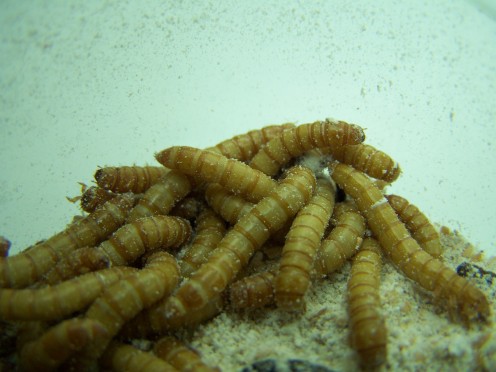- HubPages»
- Education and Science»
- Life Sciences»
- Entomology
Live Feeder Insect Food List
Growing your own feeder insects will save you money in the long-run. There are numerous species to choose from, with several being simple to care for. Here I talk about two types of feeder insects. I will add more as time allows! Eventually, each one will have their own Hub.
© Copyright Notice ©
My photographs are mine, taken by me, with my camera. You may use them for personal reasons (desktop backgrounds, personal websites or you can print them for personal use.)
If you choose to use them on websites I require a link back to my HubPages. You may link to my profile or to one of my Hubs.
You may not use them without my permission or for profit.
I sell my art and if you are interested in purchasing it send me a message.
ALL of my articles are MINE and you may NOT use them for anything but reading on my page.

Black Soldier Fly Larvae:
Black soldier fly larvae are the immature maggots of the Black Soldier Fly. Unlike other maggot species, soldier fly larvae have a rough skin texture and are not slimy. They are often called grubs because they resemble them so.
Establish your soldier fly culture by purchasing a starter colony on Ebay, or some other reputable website.
The flies that come when the larvae mature do not bite and avoid humans at all costs. They look more like small, chunky wasps that cannot sting. The soldier fly is a medium sized fly, ranging to around 1/2 of an inch long. Like other flies, it has a fat body but a clear-ish section that makes it seem much thinner.
Feed soldier fly larvae just about anything. If you wish to avoid rotting meat, try feeding them livestock dung, kitchen scraps or even chicken feed.
Provide a well-drained substrate for them to live in. Soldier flies will self-harvest if you provide a ramp for them to climb out of their container. Collection is simple, simply place a bucket where the maggots will fall into it.
Feed soldier fly larvae to rats, mice, lizards, birds, fish and anything else that normally eats meat.
In my upcoming E-book, I will have a detailed section on raising these larvae in a clean and healthy manner.

Mealworms:
Mealworms are the larvae of the darkling beetle. They are extremely easy to raise and make excellent additions to the diet of your reptiles, mammals, fish, and birds.
Provide mealworms with as large a container as you can. Feed your mealworms any kind of grain you wish. They are not picky. Make sure you either microwave or heat over the stove your mealworm food. Heating for a few minutes will kill any grain mites or other pests in the grain. Just because you do not see the mites, does not mean they are not there. Over time, meal mites can kill your colony.
Provide mealworms with a wadded up piece of damp paper as a moisture source and a place to hide. Re-dampen the paper as needed to keep it like a wrung-out sponge.
I like to add beet slices to my mealies container. They love it and its good for them. Any moist, organic produce will water and feed them. Mine love apples, potatoes, tomatoes, and just about anything else. Always make sure the produce you feed your babies is pesticide and herbicide-free.
If you are attacked by mites, sift the mealworms out and wash them with clean water through a mesh screen. It takes about 60 seconds of thorough washing to remove the mites. Quickly slap the mealworms on wadded-up dry paper towels to prevent drowning. Always use heat-treated grains for your mealies! Mites have been known to survive 0 degree temps so freezing substrate might not be effective. High humidity can cause large mite outbreaks.
Why not give mealworm farming a try!
Purchase starter colony mealworms on the Internet, Ebay and even Amazon!
I have a special, healthy diet for my mealworms that I will share in my upcoming E-book!







